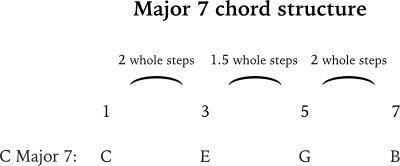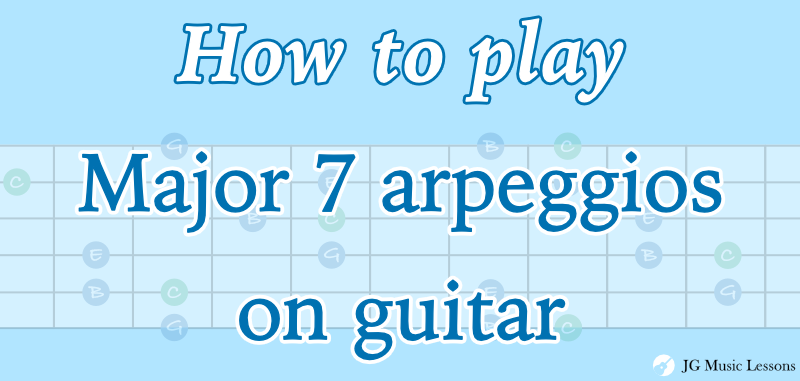If you want to take your improvisation skills to the next level, it’s important to have a solid understanding of Major 7 arpeggios. Arpeggios are so effective because they highlight the important notes of a chord.
If you’re familiar with Major triads, this concept goes one step further to include another note in the chord structure.
In this post, we’ll specifically look at how to play Major 7 arpeggios shapes on guitar and application examples over different chords. Grab your guitar and let’s start learning!
Understanding Major 7 Arpeggios
Before learning to play arpeggios, it’s important to understand what Major 7 chords are and how they are built. Every Major 7 chord is built upon the following four chord tones: 1, 3, 5, and 7. These chord tones can also be thought of as the scale degrees related to a Major scale.
For example, the C Major 7 chord has the chord tones C, E, G, and B. This is essentially a C Major chord with an added 7th chord tone.
Here is the formula for Major 7 chords below.

Now that you know what notes belong to the Major 7 chord structure, let’s look at how to read the chord charts.
How to read the chord charts
For the chord charts below:
- The top horizontal line of the chord chart represents the high E string and the bottom horizontal line represents the low E string.
- The vertical lines separate each fret.
- The green dots represent the root note.
You can check this link for more on how to read guitar notation symbols.
Major 7 arpeggio shape 1
Here is the first shape with the root note starting on the 6th string. You can use any root note to play these examples but we will cover application examples later in this post.
For the following charts, the left side shows you the suggested fingering for an arpeggio and the right side shows you what chord tones you are playing.

Major 7 arpeggio shape 2
Here is a second way to play to a Major 7 arpeggio with the root on the 6th string. This arpeggio is more difficult because requires a wider stretch between your fingers.

Major 7 arpeggio shape 3
Here is one another arpeggio shape with the root note on the 6th string.

Major 7 arpeggio shape 4
Now, here is the Major 7 arpeggio shape with the root note starting on the 5th string.

Major 7 arpeggio shape 5

Major 7 arpeggio shape 6
This arpeggio shape blends the last two shapes.

All arpeggio shapes on the fretboard
To help you connect all the shapes we learned, here are all the arpeggio shapes on the fretboard using a C Major 7 chord arpeggio.
C Major 7 arpeggios

E Major 7 arpeggios
Here are all the arpeggio shapes on the fretboard using an E Major 7 chord arpeggio.

G Major 7 arpeggios
Here are all the arpeggio shapes on the fretboard using a G Major 7 chord arpeggio.

Major 7 arpeggio application examples
Now, we’ll look at some application examples of using arpeggios over a C Major 7 chord. You can listen to each example below the notation with tabs.
Application example 1
This first example uses an ascending four note pattern using only the C Major 7 chord tones: C, E, G, and B.

Application example 2
Next, we have a similar example as the previous one except we’re playing a descending four note pattern.

Application example 3
Now, we’ll incorporate the arpeggio with other scale and chromatic notes.

Application example 4
For this example, we are imposing a G Major 7 arpeggio over the C Major 7 chord. This creates a lydian sound which highlights the raised 4th degree.

Application example 5
This last example also uses a G Major 7 arpeggio with a descending note and rhythm pattern.

Wrapping up
Arpeggios are a foundational part of improvisation because they highlight the important notes of a chord. If you practice this concept, you’ll find that your solos have much more clarity over the chords you’re playing over.
As you become more comfortable playing arpeggios over a specific chord, also try incorporating other scale notes or try different rhythmic ideas to make your ideas sound more musical. You can also challenge yourself to play arpeggios examples or ideas over different chords.
Check out these other posts to learn how to play minor 7 arpeggios, Dominant 7 arpeggios, or half diminished arpeggios on guitar.
I hope this helps you to create more interesting ideas when improvising. Happy practicing!
📘 Get the free guitar practice guide here!
Best,
JG Music Lessons
Start Playing Better, Faster
by becoming a Pro Member! ✨
Transform your playing by enjoying benefits such as:
• 📙 Exclusive Lesson PDFs and Ebooks
Get access to a growing library of clear, downloadable resources—save time and skip the clutter.
• 🎼 Full Song Lessons
Break down your favorite songs step by step, and play them with confidence.
• 🚫 Ad-Free Learning
Focus better with a distraction-free environment.
• 🎁 Store Discounts
Save 50% off on all song PDFs, charts, audio tracks, bundles, and design printables.
• 💬 Member Support
Got questions? We’ve got your back, helping you stay on track!
👉 Join Here!
Level up with the FREE guitar practice guide and effectively improve your playing! 🎸
Get it sent to your email!



